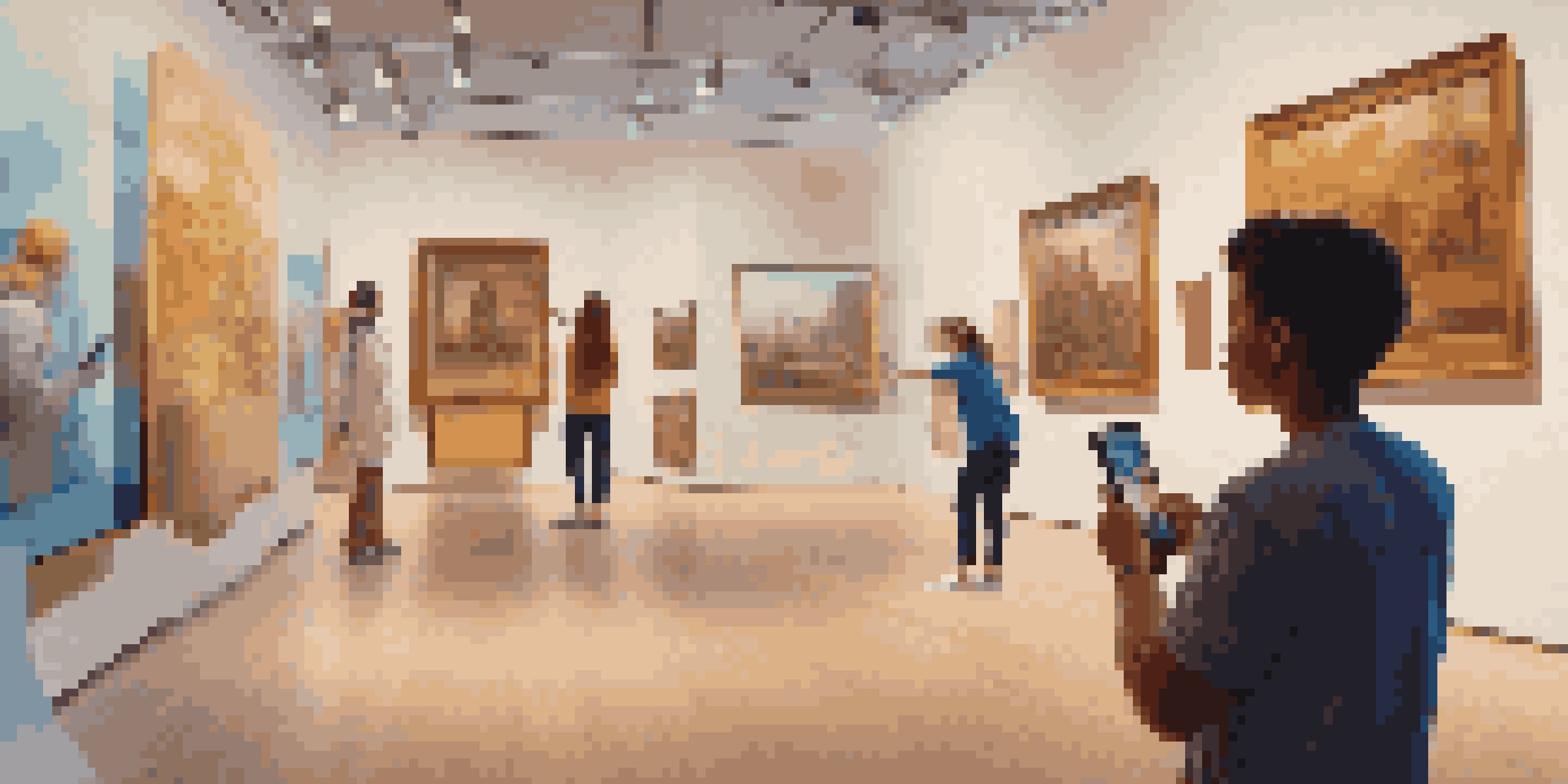AR for Enhancing Vocabulary Acquisition in Language Learning

Understanding Augmented Reality in Language Learning
Augmented Reality (AR) combines the real world with digital elements, creating an interactive experience. Imagine walking through a museum and seeing historical artifacts come to life through your smartphone. This engaging approach can be particularly effective in language learning, where vocabulary acquisition is crucial.
Augmented Reality is a powerful tool for learning, allowing students to experience concepts in new and interactive ways.
By overlaying digital information onto physical spaces, AR transforms traditional learning methods. It allows learners to visualize and interact with new words in context, making the learning process more immersive. This method can help students retain vocabulary better than conventional rote memorization techniques.
For instance, a student learning about food vocabulary might point their device at a fruit basket and see the names of the fruits displayed in both their native language and the target language. This real-time connection between words and their meanings enhances understanding and recall.
The Benefits of AR for Vocabulary Acquisition
One of the standout benefits of using AR in vocabulary learning is increased engagement. When learners can see and interact with words in a meaningful way, they are more likely to remember them. This active learning approach encourages curiosity and exploration, making the educational experience enjoyable.

Furthermore, AR caters to different learning styles, accommodating visual, auditory, and kinesthetic learners alike. For example, visual learners benefit from seeing images associated with words, while kinesthetic learners enjoy physically interacting with their environment through AR applications. This versatility helps educators reach a broader range of students.
AR Enhances Vocabulary Learning
Augmented Reality creates immersive experiences that make vocabulary acquisition more engaging and effective.
Additionally, AR can provide immediate feedback, which is essential for effective learning. As learners engage with AR experiences, they can quickly identify their understanding and make adjustments as needed, reinforcing their vocabulary skills in real-time.
Practical Applications of AR in Vocabulary Learning
Various AR applications have emerged to facilitate vocabulary learning across different languages. For instance, platforms like Google Translate offer 'Word Lens' features, allowing users to point their cameras at text and see instant translations. Such tools not only aid in vocabulary acquisition but also boost confidence in real-world language use.
The best way to predict the future is to create it.
Educational institutions have started integrating AR into their curricula, using apps that bring textbooks to life. Imagine a student reading about wildlife and using AR to see 3D models of animals, complete with their names and descriptions in the target language. This blend of information and interaction fosters a deeper connection to the material.
Moreover, AR can be utilized in gamified environments, where vocabulary learning is embedded within fun challenges. This approach motivates learners to practice more frequently, as they associate language acquisition with enjoyable experiences rather than tedious drills.
Challenges and Considerations of AR in Education
While AR offers exciting possibilities for vocabulary learning, it also comes with challenges. One primary concern is the accessibility of technology; not all students have access to smartphones or tablets capable of running AR applications. Educators must consider equitable access to ensure all learners benefit from these tools.
Additionally, the effectiveness of AR in vocabulary acquisition depends on thoughtful integration into the curriculum. Simply adding AR elements without a clear educational purpose may lead to distraction rather than enhancement. Teachers must align AR activities with learning objectives to maximize their impact.
Benefits of Collaborative Learning
AR promotes collaboration among students, allowing them to share insights and reinforce their understanding of new vocabulary.
Lastly, there is a need for training educators to use AR effectively. Professional development programs should focus on providing teachers with the skills and knowledge to incorporate AR seamlessly into their lessons, ensuring that they can leverage this technology to its full potential.
The Role of Collaborative Learning with AR
AR not only enhances individual learning experiences but also promotes collaboration among students. For example, learners can work in pairs or groups to explore AR vocabulary activities together, sharing insights and learning from each other. This collaborative approach fosters social interaction and boosts motivation.
In group settings, students can engage in discussions about the vocabulary they encounter, helping to reinforce their understanding. By articulating their thoughts and hearing different perspectives, they deepen their grasp of new words. Such dialogues can lead to richer vocabulary retention.
Moreover, collaborative AR activities can simulate real-life scenarios, such as navigating a foreign city or ordering food at a restaurant. These practical applications encourage teamwork and problem-solving, making vocabulary learning feel relevant and applicable.
Future Trends of AR in Language Learning
The future of AR in language learning looks promising, with advancements in technology paving the way for even more innovative applications. As AR becomes more accessible and affordable, we can expect to see a greater number of educational tools designed specifically for vocabulary acquisition. This evolution will likely lead to more personalized learning experiences tailored to individual needs.
Furthermore, the integration of artificial intelligence (AI) with AR could enhance language learning even further. Imagine an AR application that adapts to a learner's progress, offering customized vocabulary challenges based on their performance. This level of personalization can ensure that students remain engaged and motivated.
Future of AR in Education
The integration of AR with AI could lead to personalized learning experiences, revolutionizing how languages are taught.
As more educators embrace AR, we may also witness a shift in pedagogical approaches. Traditional teaching methods could evolve into more interactive, hands-on experiences that prioritize vocabulary acquisition through exploration and creativity, fundamentally changing how languages are taught.
Conclusion: Embracing AR for Effective Language Learning
In conclusion, Augmented Reality presents an exciting frontier for enhancing vocabulary acquisition in language learning. Its ability to create immersive, interactive experiences can transform the way learners engage with new words. By bridging the gap between the digital and physical worlds, AR enriches the educational landscape.
As we navigate the challenges and opportunities of this technology, it’s essential for educators to stay informed and open-minded. By embracing AR, teachers can create vibrant learning environments that inspire curiosity and foster deeper understanding among their students.

Ultimately, as AR continues to evolve, it holds the potential to revolutionize language learning, making vocabulary acquisition not just effective but also enjoyable. The journey of learning a new language can become an adventure filled with discovery and excitement.